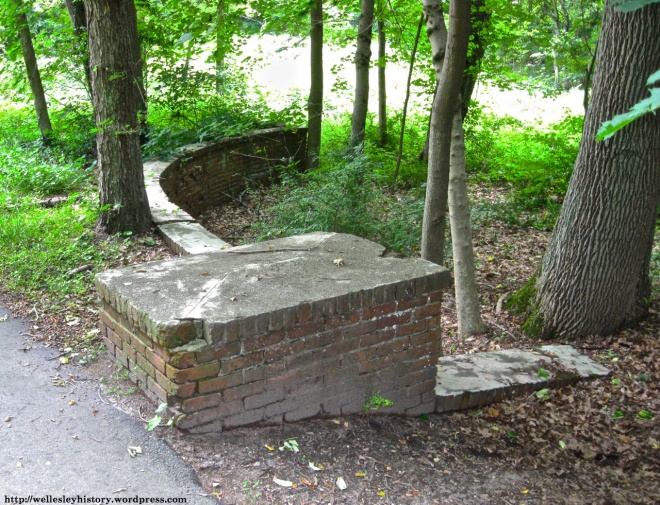This article appeared in the Wellesley Townsman on July 24, 2014.
The photograph above shows the western end of ‘The Waterway’ off Hillside Road in Wellesley Farms. Constructed sometime between 1894 and 1897, the Waterway consists of a brick-lined canal and basin that was at the center of Indian Springs Park, an ambitious 40-acre subdivision bounded by Washington Street, Glen Road, the Cochituate Aqueduct, and the Boston & Albany Railroad.
Local lore suggests that residents living there at the turn of the 20th Century may have taken Sunday strolls around the canal in their horse-drawn carriages.
Prior to its subdivision, the property had been owned by William Heckle, a successful importer and dealer of millinery and bonnets, who had built a large mansion on his land around 1874 (at the current site of 7 Hillside Road). This house was constructed out of large cement blocks and was known therefore by the townspeople as Heckle’s Castle. (It burned down in 1909.)
In 1894, Heckle and his family decided to leave Wellesley and sold the property to a group of three lawyers, including his own personal attorney (Henry T. Wills) as well as a neighbor who lived at 51 Glen Road (Harry J. Jaquith). But given that Heckle had previously developed the Crescent Street neighborhood and Heckle Street, it is likely that he was involved in the Indian Springs Park subdivision in some way or another.
Despite the construction of the attractive park-like Waterway, the Indian Springs Park subdivision was a failure. Although there were a handful of residences constructed there through the first decade of the 20th Century, many more would have been needed to make the development financially profitable.
The reasons for this shortcoming are unclear, but it was probably because there was competition from two other exclusive neighborhoods that were being developed at that time — the Belvedere Estates and the Cliff Estates — both of which appealed to the town’s wealthy newcomers. Those latter neighborhoods provided more privacy, and perhaps more importantly, were far removed from Lower Falls, which was still an industrial village.
It is therefore not surprising that by 1906, given the lack of development at Indian Springs Park, the Waterway had been abandoned and was already in disrepair.
A century later, not much has changed in that regard. In fact, the condition of the Waterway is so bad that parts of its brick structure are dangerously close to collapsing. Perhaps something could be done to restore the structure so that future generations of Wellesley residents can appreciate the charm and mystique of the Waterway.

